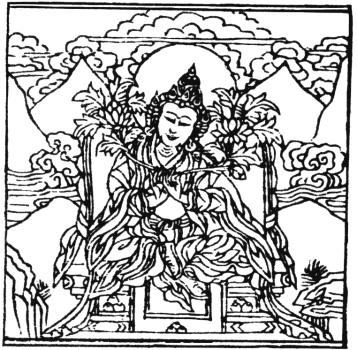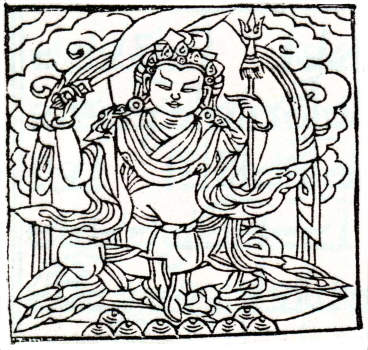 |
| 
|
| Kalkī Puṇḍarīka | Kalki Śrīpāla |
 |
| 
|
| Kalkī Puṇḍarīka | Kalki Śrīpāla |
|
The following is adapted from a translation of part of the great history of Kālacakra, "dpal dus kyi 'khor lo'i zab pa dang rgya che ba'i dam pa'i chos byung ba'i tshul legs par bshad pa ngo mtshar dad pa'i shing rta", by Amye Zhab ('jam mgon a myes zhabs ngag dbang kun dga' bsod nams). Kālacakrapāda the Elder. The one known as Kālacakrapāda the Elder (dus zhabs pa chen po) was born in Varendra (a region of northern Bengal) in eastern India. His father was a Brahmin yogin who practised Black Yamāri (gshin rje gshed nag po), and his mother was an awareness ḍākinī. They performed a ritual from the Kṛiṣṇayamāri Tantra to ensure the birth of a noble son. The father dreamed of the noble Mañjuśrī entering his wife's belly, and the child was later born together with auspicious signs. Due to the blessing of noble Mañjuśrī the child had a bright mind with clear faculties, and took ordination when he was young. He studied many subjects and understanding them all with ease he became a paṇḍita and was known as Cilupa. He heard of Kālacakra from Paṇḍita Ācārya, but was not satisfied, and through the awakening of his previous prayers he developed a powerful wish to go to Sambhala.
This is a reference to a particular cycle of commentaries, often known as the bodhisattva trilogy (sems 'grel skor gsum). Said each to have been written by great bodhisattvas, one is the Vimalaprabhā commentary on Kālacakra, and the other two deal with the Cakrasaṃvara and Hevajra tantras. He travelled to the north, but as there was physical danger due to a desolate area that would need four months to cross, he travelled together with some traders by boat across an ocean. The traders went to an island of jewels, and he travelled on to the north. He climbed a mountain on an island in the ocean, and there met a white man, who was an emanation of the Kalkī king of Sambhala. Some say this was the king Śrīpāla and others say it was Puṇḍarīka. The king asked him where he was going and for what reason. He replied that he had travelled from eastern India and was on his way to Sambhala to meet the Kalkī and request teachings on Kālacakra. The king told him that he would not be able to make such a journey, but that if he could understand such things here, would he not listen? Cilupa then understood that the man was an emanation of the kalkī and prostrated to him and circumambulated him many times. After offering a maṇḍala, he requested that he accept him as a student. The king told him "I have come here in order to teach you Kālacakra for the benefit of beings in India, so listen."
Cilupa meditated for seven days at the foot of the mountain by the side of the ocean and attained realization. He magically flew through the air to the Māla grove in Sambhala, and there, at the Kālacakra maṇḍala house, he bowed to the feet of the Kalkī in person, who gave him the complete empowerment, explained to him the instructions on the tantra and commentary, and gave him texts of the bodhisattva teachings: the Laghutantra, the Kālacakra Tantrottara, the Vimalaprabhā, the Mūlatantra, the Sekoddeśa, the Triyogahṛidayavyākara, the Paramārthasevā, the Cakrasaṃvara Piṇḍārtha commentary and the Vajragarbha commentary on Hevajra.
Kālacakrapāda the Elder had many students, among whom were three known as Kālacakrapāda the Younger: Avadhūtipa, Śrībhadrabodhi and Nālandāpa; also Nāropa, Sādhuputra, Ratnakaragupta, Mokṣakaragupta, Vinayākaramati, Siṃhadhvaya and Anantajaya. Avadhūtipa.
In accordance with this prophecy, after seven days had passed the corpse looked up and asked "What kind of intelligence do you want?" He had wanted to be able to memorize anything that he saw, but when it came to it, because of his dull mind he said that he wanted to be able to remember everything that he wrote, and this came to be. As he lived from alms, he became know as "Paṇḍita Ācārya". Later, in Madhyadesha, he became known as Vāgiśvarakīrti. He lived at the Khasarpaṇa temple. He touched the feet of Kālacakrapāda the Elder and asked him how many tantras he knew, but it is said that he could not even remember the names of those given in the answer. He was then given the empowerment and instructions (of Kālacakra), and as a result of his practice he achieved realization and became known as Avadhūtipa, also as Kālacakrapāda. He authored such works as the Padnaninamapañjikā and the sādhana of the Glorious Lunar Mansions (dpal ldan rgyu skar dkyil 'khor gyi cho ga). His main students were the younger Kālacakrapāda Upasakabodhi and his son, Nālandāpa. He also spread the teachings of Kālacakra in southern India. Nālandāpa. Regarding Nālandāpa, he was the intelligent son of Upasākabodhi, named Bodhibhadra. Having become an unequalled great paṇḍita, in order to learn Kālacakra from Kālacakrapāda the Elder in Magadha, he thought he should make a golden offering maṇḍala for this teaching. It was said that in Tibet gold could be dug from the ground, and so he went to Tibet in search.
He returned to India and presented the gold to Kālacakrapāda the Elder, who was greatly pleased. Together with Naropa he received the full empowerment and instructions on the tantra and commentary. Having practised, in one moment he achieved the ten signs, the eight qualities and the maṇḍala of his body was filled with bliss. Right there he achieved realization. His father and his aunt also heard (the teachings) from Avadhūtipa. It is said therefore that there were certain discrepancies between the explanations of the father and son. He considered that the Kālacakra would spread widely if it were spread in Magadha. At a time when the king of Magadha was the "One with the Wooden Seat", Rāmapāla (1072-1126, approx.), and Sendhapas were in charge of the vihāra of Uddandapura, he travelled to glorious Nālandā, and placed over the door of the vihāra the "Letters of Ten Powers" (the well-known monogram of Kālacakra). Underneath this he wrote: "Those who do not undertand the Paramādibuddha, do not understand Kālacakra; those who do not understand Kālacakra do not understand the Nāmasaṃgīti; those who do not understand the Nāmasaṃgīti do not understand the awareness body of Vajradhara; those who do not understand the awareness body of Vajradhara do not understand the mantrayāna; those who do not understand the mantrayāna are all those in cyclic existence, and are not on the path of the victorious Vajradhara. This being so, all pure teachers should rely on the Paramādibuddha, and take with them all pure students intent on liberation." About 500 paṇḍitas were living there, and not liking this, they argued with Nālandāpa. However, he convinced them of the profound and vast nature of these teachings, and they all gave up their own positions, bowed to him and became his students. Well known amongst these who became experts were: Abhayākaragupta, Buddhakīrti, Abhiyukta, Mañjukīrti, the Kashmiri Somanātha, Paṇḍita Parvata, Acalagarbha, Dānaśrī, Puṇya the Great, the Kashmiri Gambhira, Śāntagupta, Guṇarakṣita, and others. Also many kṣatriyas, vaiśyas and traders developed great confidence (in these teachings), copied texts and developed strong inclination (to these teachings), spreading them widely. As he stayed at Nālandā, he was known as Lord Nālandāpa. He also built there a Kālacakra temple. His qualities became equal to those of Kālacakrapāda the Elder, and throughout the whole of east and west India he was known as Kālacakrapāda the Younger. Somanātha. Regarding the Kashmiri paṇḍita, Somanātha, he was born the son of a Kashmiri brahmin, and he was able to memorise sixteen verses at one time, remembering one with each breath. Up until the age of twelve he learned all the Vedas from his father, but his mother was a Buddhist and she sent him to study Dharma from an excellent great Kashmiri paṇḍita called Brāhmanapāda, also known as Sūryaketu. This paṇḍita had a daughter who found Somanātha very attractive and told him that in order to request teachings the two of them should be as a couple. He acted accordingly and heard many teachings, and he and the other main students, Sonasahi, Lakṣmiṃkara, Jñānaśrī and Candra Rāhula, all became paṇḍitas expert in the the five subjects. In particular, Somanātha became expert in the "Noble cycle of Guhyasamāja" (the tradition that comes from the "noble" Nāgārjuna) and Mādhyamika. At that time, paṇḍita Vinayākaramati sent as a present to Bhadrapāda (meaning Brahmanapāda) copies of the Sekoddeśa (a section of the Kālacakra Mūlatantra dealing with empowerment) and the Sekaprakriyā (an extract from the third and fifth chapters of the Kālacakra Laghutantra, also about empowerment). He placed these on his head and prayed, and his students asked what they were, and if he would give them to them. He said "These are from a particular profound tantra which I have not received, and so I am unable to explain these to you." He gave the texts to the students, and Somanātha, having looked at them, developed great respect for them. He broke off his studies and headed to Magadha to investigate these teachings. He met the father and son Kālacakrapāda the Younger, and heard the entire cycle of the bodhisattva teachings (the bodhisattva trilogy), empowerment and instructions on the tantra and commentaries, and so forth. He also listened to the Abhidharma. Having mastered all these instructions he achieved the pacification of the winds, and saw all objective phenomena as only the play of awareness. He could not be overpowered by thieves, he had the ability to withhold bodhicitta without release, and was greatly blessed. He became known as truly (an embodiment of) Mañjuśrī. He then travelled to Kashmir, debated with the Kashmiri Ratnavajra, and won by refuting his Cittamātra view. Ratnavajra told him that lest his students should come not to have confidence in him, he (Somanātha) should go somewhere else. At that time the Kalkī Puṇḍarīka came to him and told him "You should go to Tibet and spread widely the teachings of definitive meaning", and on the basis of this prophecy, he travelled to Tibet. Last updated 4 February 2010. |